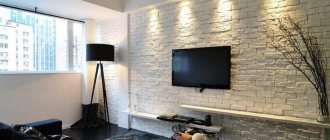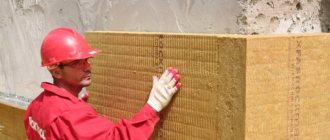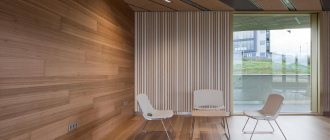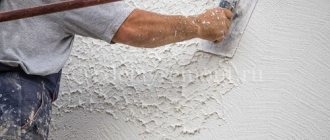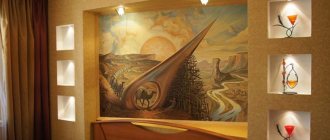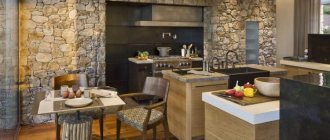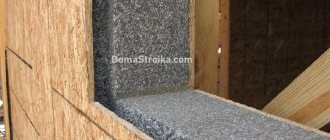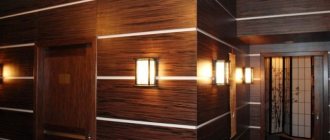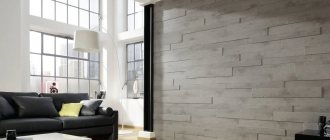Many people know what plaster is. This is a finish that gives the building a complete look, serves to protect structures from adverse influences, and extends the service life of the structure. You can entrust this to professional plasterers, but even a beginner can plaster walls with his own hands.
This requires practice and knowledge of some basics. And skill comes with experience. What is plaster used for? How to plaster walls in a new building? What is needed for plastering walls? We will try to answer questions that are important for a beginner here.
Why do you need to plaster the walls in your apartment?
Even a loft-style interior is just an imitation of untreated wall surfaces using concrete-like plaster. Plastering walls in an apartment solves many problems in a comprehensive manner.
Plaster coating:
- strengthens brickwork;
- protects concrete and aerated concrete surfaces from the penetration of moisture from the air;
- prevents the formation of fungal or moldy lesions;
- protects wood from cracking, rotting, insects, rodents;
- levels uneven surfaces of walls and ceilings;
- serves as additional insulation;
- absorbs noise;
- creates a comfortable microclimate in the apartment;
- monolithizes the internal surface of the apartment, sealing the seams and joints of structures;
- protects wood from fire;
- protects building structures from external influences;
- Levels surfaces in accordance with state standards, which makes tiling or plasterboard, wallpapering, and painting easier.
Replacing a wall or partition is more expensive than replacing or repairing plasterwork. Modern plaster compositions are durable - service life reaches 25 years or more. Plastering the walls of a house simultaneously solves many problems.
What are the application methods?
Depending on the size of the surface to be plastered, as well as the included components, methods of applying plaster can be:
- manual (trowel, roller, trowel, ladle or just hands);
- mechanized (using a hopper, plastering machines).
The choice of application method is often dictated by how much plaster can be applied per pass. When performing work manually, some types of mixtures are applied in a layer up to 6 cm thick. Mechanical application is limited to creating a layer of up to 20 mm.
Among the manual methods of plastering walls, there are different application methods:
- technical (leveling) finishing with or without beacons;
- decorative (application with various tools, shaping the surface using various techniques) finishing.
Manual application
Plastering walls with your own hands involves applying a solution to the base with a hand tool, leveling, smoothing or forming a textured surface in one pass, or sequentially creating a multi-layer coating. Manual plastering of walls is usually carried out with a small coverage area, a total thickness of the leveling layer of up to 10 - 12 cm, and a final textured finish. With multi-layer finishing, each layer is dried.
Mechanized application
It is rational to use this method of performing plastering work when there is an optimal combination of plastering speed, low cost of materials (part of the money is saved on expensive machine work), and a large volume of coating.
Plastering walls using a plastering machine is more economical in terms of:
- expenditure of effort;
- time spent;
- consumption of plastering materials;
- financial expenses for the purchase of plaster mixtures, which are cheaper for machine work.
Other advantages:
- small volumes of waste;
- uniform application and improvement in quality, due to machine control of the SS-water ratio;
- supplying the mixture to the surface under pressure increases adhesion to the base;
- Due to the uniformity of mixing and layer application, the overall strength characteristics of mechanical finishing are higher than those of manual finishing.
Minuses:
not always, not applicable everywhere
Mechanical equipment for plastering varies in level of sophistication. They use small-scale mechanization (hoppers, sprayers) or even machine devices that mix the plaster mixture and apply it when air is supplied by a compressor.
Apply the mixture, holding the nozzle 20 - 30 cm from the wall, moving the working part of the apparatus along the surface at the same speed. After finishing work, all parts in contact with the solution are washed and dried. Be sure to use eye protection.
Sealing cracks
It is common for new buildings to undergo a shrinkage process within a year or two. Plastering new houses with mineral plaster solutions during this period leads to the appearance of cracks. Cracks also occur in houses with a long service life. All cracks need repair. Large cracks require special repairs. Such defects are “healed” using reinforcing mesh.
Cracks with an opening of up to 5 mm are considered small. They can be covered with putty or cement mortar, which is more liquid than masonry mortar. Medium cracks on the surface opened up to 10 mm are “treated” with a CPS solution (cement-sand), having previously been expanded. Large (more than 10 mm) formations are sanitized with a solution using crushed stone and reinforcement.
They try to pump the solution deeper into the crack, using a construction syringe for this. Before sealing the cracks with the solution, the area of the brick and concrete wall is cleaned of dust and moistened. A piece of mesh is placed over the area with the crack body covered, which is secured to the wall with self-tapping screws. Plaster the area over the mesh.
Joint jointing of brickwork
Sealing cracks with a construction gun
Fastening the reinforcing mesh
Plaster over mesh
How to buy material profitably
Everyone wants to save money, because repairs are always a costly undertaking and there is not always enough money so as not to deny yourself anything. You can really save money and still get quality material. You need to contact our store for help; experienced consultants will select the material for you, provide advice on how to work with it and where it is best to use it. Also with us you can find the best prices for materials from the best manufacturers. This is the best way to save money when choosing decorative plaster.
You should not skimp on the quality of the material, because there is no point in doing so. You bought cheap plaster from an unknown manufacturer. But during work it turns out that it is almost impossible to level the surface with its help, it is not brought to the desired consistency, and does not allow you to create the desired texture. As a result, such material is simply thrown away, and you have to spend time, effort and money on dismantling work. Therefore, it is better to immediately buy good quality material in order to finish the repair later and get the desired result.
How to prepare walls for plastering
Beginners will need to know how to prepare walls for plastering. Preparing walls for plastering begins with an inspection.
Need to find out:
- what material are the walls made of?
- how strong is the foundation?
- how tightly the plaster coating, if any, holds;
- are there any peeling places (check by tapping);
- are there any other defects that require elimination;
- How smooth are the walls themselves (measurements are taken).
General preparation
According to the standards, the base for plastering must be dust-free, free from foci of biological damage, oil and rust stains, efflorescence, and uninsulated metal parts (staples, nails, screws). The plaster coating has a considerable specific gravity.
Before plastering the walls, they make notches with their own hands and deepen the seams to increase adhesion. The base is primed and then dried. In addition, preparation includes the installation of beacons if plastering is carried out along them.
Priming walls and installing beacons
Removing old plaster
If the old plaster coating is durable and adheres well to the wall, plaster the walls using the old plaster. The coating unnecessary for subsequent finishing is removed completely. This is required when the old plaster cover is severely damaged.
Before removing the finish, it is wetted using a sponge. If there is drywall under the plaster being removed, then it can be easily tapped. Having tapped and chipped the partially exfoliated area, peel off the adjacent plaster by inserting a corner of a spatula or chisel under it.
For complete dismantling you may need:
- Bulgarian;
- hatchet;
- hammer;
- putty knife;
- perforator;
- scraper;
- spray;
- safety glasses, respirator.
Necessary tools for dismantling old plaster
Sequencing:
- wet the plaster coating, give it time (15 - 20 minutes) to soak;
- use a spatula to check the looseness of the layer;
- remove the layer using possible means (with a spatula, chisel, hatchet, or sawing the finish into squares with a grinder, followed by chipping it off with a hammer drill with a chisel attachment).
How to prepare a concrete wall
Often inexperienced people have problems when plastering concrete walls with their own hands. Not every plaster solution adheres well to a base of this kind. Previously, plaster mortar was applied to concrete surfaces without the use of primers. Therefore, there is a possibility that the old coating may fall off the concrete wall along with the new one.
To prevent this from happening, the old finish is completely removed from the concrete walls. When the structure is exposed, the joints of the wall panels, which were usually simply covered superficially, are also exposed. Hollow joints are filled with foam before sanding.
Foaming concrete slabs and scoring before plastering
Also, before plastering, notches up to 3-5 mm deep are applied to the concrete surface with a hatchet, chisel, bush hammer or hammer. To apply notches, a light jackhammer with a bush hammer attachment is sometimes used. Unevenness increases the adhesion of dense concrete bases to joints.
If the electrical wiring is planned in grooves, then its installation is done before plastering. Fastening elements, such as hanging hooks, are installed in advance.
This eliminates unnecessary labor, time and materials costs later.
Preparing a wooden wall
Wood especially needs preparatory work. It is not always rational to apply notches. Therefore, before plastering, wooden bases are covered with shingles - thin slats no wider than 20 mm. The shingles are nailed to the surface of the base, placing the slats at an angle of 45 degrees to the floor, at a distance of about 4.5 cm from each other.
The narrow or crooked shingles are filled first. The second row of shingles is nailed crosswise on top. To prevent the planks from splitting during the nailing process, the ends of the shingles are soaked.
In addition, at the ends the slats are not nailed close to each other, leaving a gap of 2 - 2.5 mm. Stuffing nails with wire weave along them helps to do without shingles.
To increase the heat and sound insulation of plank partitions, the boards are covered with burlap or matting before attaching the shingles, lowering the woven material until it touches the floor. Having nailed it along the bottom, tighten and attach the upper end.
These materials adhere well to solutions, serve as additional insulation for boards, and reduce wetting and warping of the boards. Then the plaster coating cracks less. The edges of the fabrics are overlapped.
Preparing a brick wall
In brickwork, before plastering, masonry joints are deepened by about a centimeter. This is done with a chisel, holding the tool at an angle of up to 45 degrees to the surface along the seam line. Bricks are cleaned from contamination with metal brushes. Then the wall is washed.
If, after washing with detergents, greasy or tar stains or efflorescence appear, they are treated with special agents or mechanically cleaned until the material is clean. After preparation, the base is dried.
Aerated concrete, gas block, foam block
How to prepare walls from these materials? It would seem easier with them. All protruding irregularities are ground off with a float designed for aerated concrete or a plane. After removing the dust, apply primer with a brush or from a sprayer twice. Dry between priming, allowing crystals to form and fill the surface pores.
Priming the wall
Installation of reinforcing mesh
Installation of beacons
Partitions and walls made of foam and gas blocks do not shine with strength, therefore they can crack at the slightest subsidence of the foundation. To strengthen the surface, it is reinforced with a fiberglass mesh, which is attached to a 2-3 mm layer of tile adhesive. The glue is spread with a spatula and stretched with a trowel. Apply glue in a strip about a meter wide. Apply a strip of mesh to it, smoothing it from the center of the strip up and down.
Having installed the grid, beacons are installed. Before plastering, apply a layer of glue on top of the mesh with a spatula, combing it (to increase adhesion) horizontally with a notched trowel. Dry it.
Arbolite slabs
Due to their roughness, wood concrete slabs always adhere well to the plaster finish. Therefore, no additional measures are required. Some plasterers attach a metal mesh to the wood concrete to strengthen the wall itself.
Whitewash
It is impossible to plaster over lime whitewash, because the coating will not adhere firmly. Whitewash is always multi-layered, and plaster adheres only to the upper lime film.
Whitewash is removed in several ways:
- remove with a spatula (wet, painstaking method) - moisten the areas, after 15 minutes remove the soaked lime;
- remove with a grinder (the disadvantage of this method is that there is a lot of dust, you need to work in a respirator and goggles);
- Apply the paste with a brush in a thick layer to the whitewash. After drying, the pasty crust, which holds together the multi-layered lime mortar, is removed with a spatula (the most dust-free method);
- wash off with a soap solution (half a piece of grated soap in a bucket of water, 5 tablespoons of soda), repeatedly wetting the whitewash with a sponge or brush;
- washed with acid solutions.
Plaster on painted walls
According to generally accepted rules, paint should be removed before plastering. However, if the matter does not concern wet rooms, as well as stacks with a large dead weight, the durable paint film does not need to be removed. Light gypsum plaster applied over paint holds up well.
Methods for removing paint:
- soak for 20 minutes and remove with a spatula (for water-based emulsion);
- the use of special softening solutions;
- heating and softening with a hairdryer, scraping with a spatula;
- removal with a metal brush;
- removal using mechanical means - grinders, etc.
Preparation of painted walls for plastering includes:
- applying cuts on a base painted with enamel or oil paint that pass through the paint film;
- removing exfoliated areas with a spatula;
- removing the glossy layer with sandpaper or a sander;
- removing dust with a damp cloth;
- degreasing oil stains with a solvent;
- drying the prepared base.
Required tools and materials
List of what will be needed for plastering:
- for preparing the solution - containers, mixer, mortar mixer;
- for application - spatulas (in simple terms - spatula), ladle, trowel, trowel, rollers, brushes;
- for stretching, leveling - grater, grater, rule;
- for priming, forming a relief pattern, painting: rollers, brushes, brushes, sponges, stencils, other improvised means;
- for measuring, marking, installing beacons - level, plumb line, tape measure, masking tape, cord;
- for painting – brushes, sponge, rollers, spray bottle;
- for protection – glasses, respirator, gloves, work clothes
Materials you will need:
- components of plaster composition, SS or ready-made compositions;
- water;
- primer;
- shingles;
- lighthouses;
- reinforcing mesh;
- fastening parts - dowels, screws, nails;
Required material for plastering
What is lighthouse plaster?
The technology for plastering the walls of a house includes options:
- under the falcon (alignment without rules, by eye);
- as a rule (does not allow you to easily achieve high evenness of the walls);
- along the lighthouses (high-quality finishing).
It will not be possible to plaster a crooked wall with high quality by eye (without beacons). Therefore, the falcon-like wall plastering technology is used only in new buildings with improved quality walls, or in utility rooms where the quality of the surface is not important.
A lighthouse is a plank, the surface of which serves as a guide for the rule, moved by the plasterer when leveling the mortar applied to the wall. Lighthouses are made of metal, plastic, wood, or mortar used for plastering. The beacons have a shelf height of 6–10 mm and are attached to the base with mortar or self-tapping screws.
The installation of beacon strips is carried out plumb or level strictly vertically after priming. First, the outer beacons are placed 30 cm from the corners of the walls. The surface of the planks forms a vertical plane, focusing on which the intermediate planks are installed. The distance between the planks is made less than the length of the rule by 20-30 cm. For beginning plasterers, it is more rational to place beacons in meter increments.
When plastering over beacons, the mixture is applied in layers until the solution rises above the planks. The protruding mortar mass is cut off with a rule tightly pressed to the beacons, moving it in a zigzag manner.
The excess is removed from the rule with a trowel or spatula and placed where the mixture is missing. As a result, the surface of the leveling solution forms a vertical plane. After the mixture has set, the beacons are removed, and the remaining grooves are filled with plaster mortar.
Pros and cons of decorative putty: which is better
Putty has gained popularity and widespread use not only due to its range, but also due to a lot of advantages:
- The material is easy to install. The difficulty when working lies only in the high-quality preparation of the surface on which it will be applied. The wall must be smooth, without flaws or defects, primed and dried so that the plaster adheres well.
- With a properly prepared surface, the putty will retain and not allow heat to pass through.
- Gives an aesthetic appearance to the room.
- Wide range of textures and designs.
- Durability.
- It does not require special care.
The disadvantages include the high cost, but this justifies a lot of advantages. The material is difficult to remove the next time the interior is renovated, and if applied incorrectly, its integrity and service life are compromised.
Plaster reinforcement
Mineral plaster compositions do not have elasticity, and therefore, like natural stone materials, they can crack at the slightest movement of the base and form cracks during the hardening process, for example, if the plaster solutions are greasy. In order to reduce crack formation and their opening, the plaster is reinforced.
The same is done when repairing large cracks. The use of reinforcement increases the strength of the finish. Installation of nets is necessary in problem areas, for example, at the junction of bases made of different materials, for example, walls made of wood and concrete. Different characteristics of materials cause them to behave differently when temperature or humidity changes. Consequently, cracks will form in the joint area.
For reinforcement, meshes are used from:
- metal;
- plastic;
- fiberglass;
The choice of material and cell size of the reinforcing mesh depends on the main purpose of the reinforcement and the installation location. If powerful meshes are installed to reinforce facade finishing or create a plaster casing for insulation slabs, then for interior finishing, as well as where the plaster layer is small, plastic or fiberglass meshes are used.
Grids are a hidden structural element located in the body of the plaster closer to the surface. If the plaster coating is thick, two or more meshes are installed. When attaching the mesh to a wall or ceiling, a gap is left between the mesh and the base, which is filled with adhesive or plaster. This is done so that there are no air bubbles left around the mesh panel. The mesh must be recessed.
To secure the mesh to the walls, its panels are stretched, nailed or attached with self-tapping screws. Adjacent canvases are overlapped. It is important to tighten only so that there is no sagging, so that the wall does not turn out crooked. Do not overtighten.
If the mesh material can corrode during a chemical reaction, for example, with lime plaster, the mesh is protected by covering it with asphalt or coal tar varnish, oil paint, or laitance and drying.
Types of decorative plaster coatings and application methods
It would be unfair to those who want to save as much as possible to remain silent about one “life hack”. You can create a unique decor using ordinary plaster or putty.
What it will be - gypsum, polymer, acrylic or cement - is not so important. The application technology is of greater importance, on which the final result actually depends.
There are not so many effects that give walls or other bases a unique style:
- bas-reliefs - patterned, unique, repeating or one-piece relief paintings - plot or abstract. Still lifes, for example, are suitable for decorating the kitchen, battle works for the living room, and intimate works for the bathroom;
- smooth and polished to a gloss, textured imitation of marble, stone, metal, wood (“Venetian plaster”). Due to the high price of materials, they are usually used in limited areas - aprons, columns, niches, etc.;
- textured (volumetric) imitation of tree bark, concrete, “beetle-eaten” surface, leather, cracked soil, “fur coat”, “lamb”, etc. Suitable for any room, filling the main areas of the walls.
Obviously, the third type of decorative plasters in the interior is, in fact, the work of an artist-sculptor. It requires maximum investment of time and money. Smooth textured coatings are easier to create, but not much easier.
The most affordable option is relief textures, which do not require a perfectly prepared base and special skills of a craftsman. However, there is nothing “super complex” in any of the types of decor. Therefore, it is worth briefly reviewing them all.
Preparation of the solution
There are three possible options here:
- preparing the mixture by mixing the components yourself;
- dilution of the SS composition with water or a diluent;
- mixing the finished plaster dough before use (with or without adding a small amount of liquid).
If you prepare a mixture yourself from components purchased separately, then you need to follow the sequence of mixing the constituent substances.
DSP is prepared in the following order:
- Bulk dry substances (sand, cement powder, perlite, stone chips) are placed in the container;
- stir;
- prepare the liquid separately (lime milk, water with a plasticizer, etc.);
- while stirring, gradually pour the liquid into the dry mixture until the desired consistency of the solution is achieved;
- The composition is allowed to “rest” and brew for about 5 minutes, after which it is stirred again.
Preparation of dry mixtures
Mixing the solution
Ready-made solution
If the mixture is prepared in a mortar mixer, then it is permissible to first pour some water into it, then add other components. The remaining water is added little by little, controlling the consistency of the dough.
Purchased SS are closed following the manufacturer's instructions, which are in the detailed instructions on the package. The prepared mixtures in buckets are also mixed before use to restore homogeneity to the composition. If the plaster solution is painted, it’s time to add color.
Some plaster compositions have their own nuances. For example, perlite sand is very dusty. It is moistened before kneading. In addition to knowledge about the rules for preparing the base, you will need information about how to properly apply the plaster itself to the walls, in what sequence, how long and how it should dry.
How to update?
Attention: If over time the old wall covering has become dull, the plaster can be renewed without much expense or effort. It is worth considering the fact that larger surfaces are capable of accumulating dust and dirt in folds and depressions. You can also use a rag or broom
Decorative plaster can be wiped with a wet sponge, since most materials use water-repellent elements, or they can be coated with a special varnish for protection. Therefore, even bathrooms can be covered with such plaster, but when cleaning you should not rub too hard so as not to damage the surface.
You can also use a rag or broom. Decorative plaster can be wiped with a wet sponge, since most materials use water-repellent elements, or they can be coated with a special varnish for protection. Therefore, even bathrooms can be covered with such plaster, but when cleaning you should not rub too hard so as not to damage the surface.
The step-by-step update looks like this:
- First you need to remove dust particles and any dirt that does not stick to the walls with a vacuum cleaner.
- Minor damage can be restored using the same material as when plastering the walls, so do not lose information about what type of plaster is currently covering them.
- Wait until the layer dries.
- Cover old walls with a new layer of varnish for decorative plastering.
- You can also change the original color. Thus, not only updating the appearance of the walls, but also breathing something new and interesting into it.
To summarize, it should be noted that there are several main options for decorative plaster:
- structural;
- Venetian;
- textured;
- artistic.
Depending on its type, the methods of application to walls, as well as application technologies, differ. This type of wall covering is practical, durable, and easy to maintain. It is advisable to consult with an experienced craftsman before you start plastering the walls.
How to apply plaster on walls with your own hands
The mixture can be applied by pouring and spreading. Plastering surfaces using the first method is more dense; the finish adheres more firmly to the base. You can throw the composition with a ladle, a spatula (trowel) with a steel blade. The solution is scooped out of the container and thrown from the tool onto the base, where it lies down and sticks like a thick blot - a “slap”. Spread the dough with a spatula, trowel, or falcon.
The solution, applied to a spatula or trowel with an auxiliary spatula, is transferred to the wall with a stroke of a specified thickness. The plasterer places the tool with the dough against the wall at an acute angle, and moves it along the wall, decreasing the angle as the material is transferred to the base. If the smear begins on a previously made smear, the technique is called “wet to dry.”
If a smear begins on a dry spot and ends on another smear, the technique is called “from dry to wet.” Compliance with the techniques is important for decorative plaster. How to apply the final decorative finish can be found in another section of the site. Below we offer a detailed description of the method for performing rough finishing on concrete.
To perform improved and high-quality plastering of concrete walls, the technologies are similar. The first two stages of plastering walls are similar. The only difference is in the ending.
The first stage is spraying
For spraying when plastering, use a mortar mixture with a thinner consistency. The thickness of the layer for concrete, brick, aerated concrete, the thickness of the spray coating is 5 mm, for wood - 9 mm (with mesh).
Step-by-step instructions for spraying:
- We take the solution from the container onto a spatula or into a ladle and throw it on the wall between the beacons;
- we make sketches, filling with “slaps” an area about 100 – 120 cm high (from bottom to top);
- Having sprayed the area between the beacons, use a spatula to slightly level the “splashes” so that there is no empty space left in the area;
- we mark the surface of the layer with the sharp edge of a spatula to increase adhesion;
- we do the same, spraying to the top of the wall;
- Spray the following sections of the wall and leave to dry.
Second stage - soil
The main (base) layer applied on top of the spray is called primer. To create a thick multi-layer coating there can be several of them. For the soil, prepare a dough with a thick consistency. For application we use spatulas and a rule.
Execution of soil:
- Using a narrow spatula, place the dough from the container onto a wide spatula.
- We transfer the solution to the wall, lightly pressing it into the marked grooves of the spray.
- We remove the mixture protruding above the beacons from the bottom up using a rule, pressing it against the beacons and rocking it in the horizontal direction. We throw the solution removed according to the rule into a container or transfer it with a spatula to where it is missing.
- After running the rule from bottom to top a couple of times, we run the rule from top to bottom. After such wiring, the solution will not slide down the wall.
- We plaster the remaining part of the wall in this way.
- We wait for the solution to set, remove the beacons, and cover the formed channels with the solution.
The third stage is the finishing layer of covering
The coating composition is made with the same proportions as the base one. The consistency of a solution of normal fat content is less thick than for soil, and the sand is taken in a fine fraction (up to 1.5 mm). This mixture is easier to install and more flexible. When rubbed, it forms a smooth surface. Recommended thickness 1.5 – 2 mm.
Filling voids and applying a finishing layer
Step by step guide:
- If plastering was carried out without removing the poppies, then the covering is applied to the soil that has not yet dried. Dried soil can be moistened with a roller.
- Apply the covering, leveling it with the rule. In this case, the solution fills the resulting voids and small depressions. Excess mixture is removed.
Grouting plaster
This stage is final. The smallest errors are eliminated by grouting.
Leveling is carried out - compaction of the barely dried surface of the cover - grouting with a float. Do not press the tool too hard so as not to pull off the drying layer. Smoothing is carried out in a circular motion (grinding “in the round”). Only in the corners is the grater held and parallel to the corner. On elevated areas they press more, pressing down; on depressions the pressure is reduced.
Excess protruding mixture that collects at the corner of the grater or trowel is cleaned off. The drying layer of covering is sprayed with water from a spray bottle from time to time or moistened with a soft brush. It is possible to grout in a circle using a very small amount of mortar
After grouting, smoothing is immediately performed - grouting "in acceleration". Straight-line vertical movements (up and down) are made with a clean grater with rounded corners. The grater is pressed with equal force, without removing it from the surface. They process this square by square (areas of approximately 1 m2).
Smoothing (an optional operation) is performed in the same way as grouting, only it is done with a rubber, metal or felt-wrapped float. Treat the surface twice. Once, moving the iron (in one direction) from top to bottom, the second time - horizontally.
Finishing
Why and how to sand plaster? This procedure is performed to remove the slightest protrusions remaining after plastering or puttying, if painting or wallpapering is planned for the final finishing of the apartment. The paint layer is thin and reveals even the most minor flaws. They are removed by grinding.
For manual sanding, use sandpaper, sanding mesh or a sanding block. For wallpaper, it is enough to sand the surface with 60-grit sandpaper. For paint, you need to sand it again with 120-grit sandpaper. The result is a polished surface. After sanding and removing dust, plastering the walls with your own hands can be considered complete. A little information about how corners are made.
Step by step process
To begin with, it is necessary to say that there are a huge number of types of such coatings. They all differ in their structure, components and appearance. However, each of their types can be classified as artistic or decorative coatings.
Design solutions made in several planes
Material selection
- If you plan to make decorative wall decorations with your own hands, then you should immediately decide what material is needed. The fact is that some types of such finishing coatings require artistic skills from the master, while other mixtures can simply be applied to the surface in a certain way and in a given sequence.
- It is also worth considering the technical characteristics of the selected room. Especially if there is a factor such as high humidity or sudden temperature changes. This is due to the fact that wall coverings and wall paintings are made with substances that create a kind of protective layer. But there are also products that require certain operating conditions.
Artistic design using modeling and drawing
Special attention should be paid to additional tools. To create certain types of decorative or artistic plaster, special devices or devices designed specifically for this material may be required. It must be remembered that such coatings are finishing and are not intended for leveling surfaces.
That is why it is worth thinking in advance about the main layer, Tom, which will subsequently serve as a substrate for decoration.
This type of finishing can be classified as decorative, since it creates an imitation of other surfaces and is selected individually from various bulk materials
Installation Basics
- When finishing walls or ceilings with your own hands, then, first of all, leveling should be done. Even when using materials for Venetian plaster, you need to create a small surface layer that will serve as a kind of base.
- It must also be said that almost every stage of applying a substance to a wall must be accompanied by priming. This must be done in order to create a strong bond between the layers and increase the level of adhesion of all components.
Currently, there are a huge number of rollers for applying patterns to the surface of plaster.
Special attention is paid to the fact that almost every type of such coating has its own installation technology
That is why it is very important to strictly follow all the instructions given in the instructions supplied with the selected material. The simplest mixtures for decorative plaster involve applying them to the surface in such a way that all their additional components and inclusions create a unique pattern or design. In this case, professional craftsmen advise using a polyurethane plaster float. After all, she is ideal for this job.
Type of decorative wall decoration using modeling
Some mixtures require the use of special tools. One of the most popular of them is a profiled roller, on the surface of which a relief pattern or design is applied.
Thanks to it, ornaments or other decorative elements are made on the hardening mixture. Particular attention is paid to plaster, which is created manually by sculpting and applying patterns to the surface. Usually the price of such coverage is quite high
After all, it requires the involvement of a professional. However, the beauty of the achieved result fully justifies all the costs.
Sometimes, to create an original interior, simple drawing skills are not enough and professionals are hired to do the work, who are able to turn a room into a real work of art.
Even after applying the finishing layer, which may have its own protection, it is worth treating the surface with a special primer recommended by the manufacturer of the selected material.
The simplest type of such coating can be created independently and without prior preparation.
Plastering corners
The words “husks” and “usenki” will not say anything to an ignorant person. Meanwhile, these are professional terms for plasterers, denoting internal and external corners, respectively. The technique for plastering them differs from applying plaster to walls.
The main techniques used by plasterers:
- using a profile corner;
- with lighthouses;
- with a counter-piece (perforated corner with an aluminum base));
- with serpyanka (ribbon mesh made of fiberglass or synthetics with an adhesive layer);
- without a contrarian.
Counter-shuls can be used to produce husks and usenki.
Step-by-step technology for making an angle using a contra-sharp:
- Cut the perforated corners to the required length.
- A contact solution is applied to the corner in a thick layer (the mixture is stretched along the entire length along the inner corner).
- The corner is placed against the corner, pressed most tightly in the most “protruding” place, then using the rule, the counter-shoulder is pressed so that it stands strictly vertical (check with a level or plumb line).
- The excess mixture released during installation is removed with a spatula. After this, the mixture is allowed to harden.
- After installation, the corner is aligned with the wall using a test. The corner shelves end up inside the plaster mortar. The corner counter protects the protruding corner from damage.
Applying contact solution
Installation of the corner
Removing excess solution
Aligning the corner with the wall
Making an external corner along a profile corner:
- Cut the profile corners to the required length;
- Beacons are installed on adjacent walls (the corner is plastered before work on the wall is completed);
- A contact solution is applied to the corner in a thick layer (the mixture is stretched along the entire length along the inner corner).
- Next (thicker) soil is applied on both sides from the corner to the nearest beacons.
- The corner is placed against the corner, the mesh is pressed against the mixture, using the rules, the solution is leveled along the beacons on one, then on the second wall.
- The excess mixture removed by the rule with a spatula is added to where it is missing.
- The profile corner and the mesh are inside the plaster layer.
Advantages and disadvantages of mechanized plaster
Mechanization of the plastering process allows you to automate all stages - from diluting the mixture to covering the wall with mortar.
The composition is poured into a special plastering station, which begins preparing the solution. After this, the master applies the mixture to the wall using a hose and levels the coating.
Advantages of using mechanized plaster:
- The coating formation rate is 4-5 times higher than with the traditional method.
- Saving on puttying - 1 layer is enough, whereas manual application requires 2-3.
- The cost of a mixture for machine application is 30-40% less than that of a similar mixture for manual application.
Flaws:
- Heavy equipment is difficult to lift to the floor. If it does not fit into the elevator, then it will be impossible to use it.
- To perform the work, it is necessary to connect the object to the electrical network.
- Economic benefits can only be obtained by finishing large areas of 100 to 150 square meters.
How to check the quality of wall plaster
The accuracy of the finishing is checked using a rule or a long two-meter strip. When carrying it along the surface in different positions (horizontally, diagonally or vertically), deviations from the plane are detected visually. In the dark, you can check the quality of the plaster by directing the flashlight beam parallel to the plane of the wall. Long shadows will reveal protruding irregularities.
By measuring and comparing the two diagonals of the room, you can check whether the corners of the room are right. The diagonals must be equal in length. The distance between parallel walls is the same along their entire length. The correctness of the angle can be checked by drawing vertically along a square with a side length of 50 cm.
The quality of the finishing surface is determined visually. There should be no darkening or other kinds of stains on it. The sashes of windows, vents and doors must open without interference. The areas around sockets, switches and door frames, along the perimeter of the floor must be level so that the overlay strips, baseboards and trims fit tightly against the wall.
If you are planning to renovate your apartment, but you do not have experience covering walls with plaster yourself, you should not despair. After reading the information presented and watching the videos, you have gained an idea of the main types and techniques of plastering work.
Detailed information about plaster compositions and how to apply decorative solutions can be found on the website. When contacting plasterers, you will know what to pay attention to, how the work should be performed, and why this or that stage is needed.
The work includes several stages
- You need to decide on a design and prepare all the tools that will be needed for use. While working, you should always have a relief sample at hand in order to accurately repeat all the contours.
- We begin to prepare the surface. It is imperative to clean the walls of old material, level them to rough and prime them.
- The first layer of plaster will lie evenly on the dried wall. This will be the basis for applying the finishing layer. It is necessary to properly dry the initially applied material and prime the surface again.
- When the soil is completely dry, the final layer is applied. With its help, the relief will be formed. In many applications, one piece of plaster is poured into a homogeneous mass, and textured recesses are left on the inside. This technology will allow a simple relief to look original and more interesting.
- Coloring agent. Depending on the material, the desired coloring method is selected. The paint should emphasize the luxury of the decorative coating.
Decorating walls with artistic plaster requires strict adherence to installation rules. Introducing independent innovations into relief manufacturing technology will have a bad effect on the result. It will not take a single day to create a high-quality decorative artistic coating. This is not a time to rush. The main thing is to thoroughly dry each layer.
To learn how to decorate a wall with decorative plaster yourself, see the video below.
